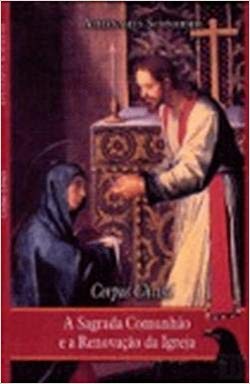Categoria: Communio in lingua genuflexis
Athanasius Schneider: Corpus Christi
Corpus Christi. La santa comunione e il rinnovamento della Chiesa
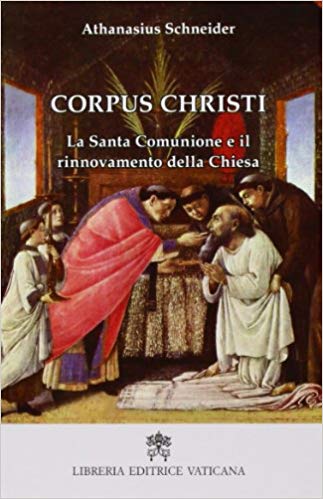
Questo volume prende in esame il mistero dell’Eucaristia correlato al crescente fenomeno di mancanza di sensibilità e di cura nei confronti dell’Ostia Consacrata e di ciò che essa rappresenta, cioè il Corpo di Cristo. Oggigiorno, infatti, i necessari atti esteriori d’adorazione e di sacralità nel trattare l’Ostia sono spesso ridotti al minimo, ma se il culto di Dio nell’eucaristia viene concretamente ridotto, allora risulterà sminuito il cuore pulsante della Chiesa stessa. L’autore offre dunque in queste pagine un prontuario, utile sia ai sacerdoti che ai fedeli laici, per risanare e valorizzare il modo di trattare Ostia Consacrata, che anche nel suo piccolo frammento non è nulla di meno del Signore stesso.
Corpus Christi: Holy Communion and the Renewal of the Church
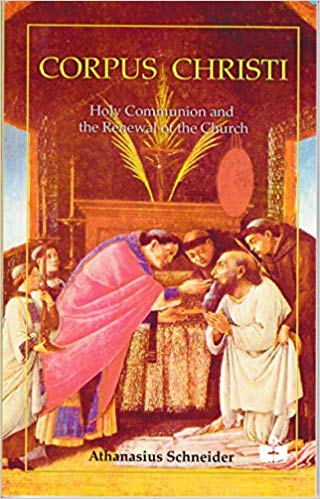
“Preferential option for the poor”: this formula is not only applicable to the marginalized, defenseless and vulnerable. “The Eucharistic Jesus … is indeed the most poor, weak and defenseless in the Church,” Bp. Schneider says. This book is a passionate plea for the faithful and the clergy to be aware of the supreme importance of receiving Our Lord with the appropriate preparation, devotion and reverence. The renewal of the Church cannot be brought about without a profound devotion to the Eucharist.
Corpus Christi – La Communion dans la main au cœur de la crise de l’Église
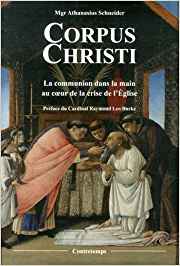
Dans l’hostie, Jésus-Eucharistie est véritablement l’Être le plus pauvre et le plus démuni de l’Église. On assiste malheureusement de nos jours à un surprenant manque de respect et d’attention envers la présence réelle de Dieu incarné dans l’hostie consacrée. L’Eucharistie est au centre de la vie de l’Église. Elle est donc au cur de la crise que vit encore l’Église aujourd’hui. Pour soulager ce mal, il faut restaurer un culte digne de Jésus-Eucharistie.
Corpus Christi: Gedanken über die heilige Kommunion und die Erneuerung der Kirche
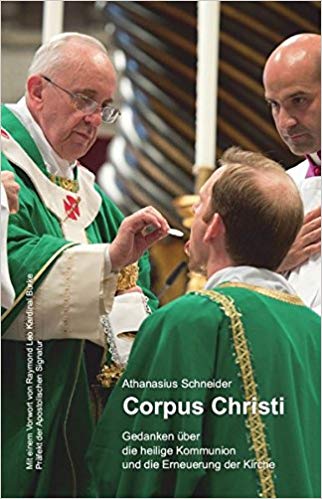
Jesus Christus, wahrer Gott und wahrer Mensch, will für immer bei uns und bei seiner Kirche sein. Deswegen hat er sich noch kleiner gemacht: er ist wahrhaft, wirklich und wesenhaft in der unscheinbaren kleinen Hostie – der Allerheiligsten Eucharistie – gegenwärtig.
In der Kommunion liefert sich Jesus Christus den Menschen aus. Unser Glaube an seine wirkliche Gegenwart muss durch äußere Akte der Anbetung deutlich werden. Die Eucharistie kniend und mit dem Mund zu empfangen, ist das angemessenste Zeichen für den Glauben an das Wunder der Gegenwart Gottes unter der äußeren Gestalt des Brotes.
Vielfach ist jedoch ein Mangel an Ehrfurcht und Sorgfalt bei der Kommunionspendung zu beklagen. So besteht die Gefahr, dass der Glaube an die Menschwerdung Gottes und an die eucharistische Wesensverwandlung mehr und mehr schwindet.
Damit die Kirche erneuert wird, ist es notwendig, den Umgang mit dem eucharistischen Jesus in der heiligen Hostie zu heilen. Denn die heilige Hostie – selbst im kleinsten Partikel – ist niemand Geringerer als unser göttlicher Herr Jesus Christus selbst.
The Flame Re-Ignites: Ad Orientem
The mind of the Council, of any council in history, is to be found in only one place: its decrees and documents. The Second Vatican Council did not countenance Mass versus populum or Communion in the hand and it if did, it would have said so, as it did with the possibility of limited use of vernacular languages in the Mass. We have seen that the old truism, give them an inch and they will take a mile, has operated with regard to the vernacular at Mass. Yet even without an inch being given by the Council Fathers, versus populum and Communion in the hand have become well-nigh universal.
Read whole post by Fr Hugh Somerville-Knapman OSB here.
Fr Hugh’s blog Dominus Mihi Adjutor. A monk’s-eye view of things.
Popular Misconceptions About the Catholic Mass
A number of liturgical reforms seen in the U.S. since Vatican II were not actually mandated or even recommended by the Council, but were reactionary shifts that had more to do with the culture of the decade – it’s time to revisit those changes.
By Michael Raia
Communion in the Hand: a post by Father B. Jerabek, J.C.L.
The Church does give us the right to receive Holy Communion in the hand. But, as Bishop Schneider says in this book that I am currently reading, our Lord Jesus Christ has rights also: above all, to be treated with the respect and adoration that belong to the Divinity.
If you were to ask me, I would advise you against ever receiving Holy Communion in the hand. I hope that at least some who read these things will be inspired to re-think their own posture with regard to Holy Communion.
Read the full post here.
Decreto de recibir la santa comunión en la boca
VISTO que insistir en la práctica general de la comunión en la boca es más conveniente en esta Diócesis, no solo para ayudar a la recepción más devota de las Eucaristía y sostener la fe en la presencia real y substancial de Jesucristo en la misma, sino también para evitar las profanaciones del Cuerpo de Cristo, puesto que se ha notado últimamente que hay personas que no consumen la Sagrada Forma al momento de recibirla, y se la quieren llevar fuera del templo con fines desconocidos,
D E C R E T O
REAFIRMAMOS PARA LA DIÓCESIS DE ORURO LA OBLIGACIÓN DE SEGUIR LA LEY GENERAL DE LA IGLESIA DE RECIBIR LA COMUNIÓN EN LA BOCA, NO SIENDO DE APLICACIÓN EL INDULTO DE PODER COMULGAR EN LA MANO.
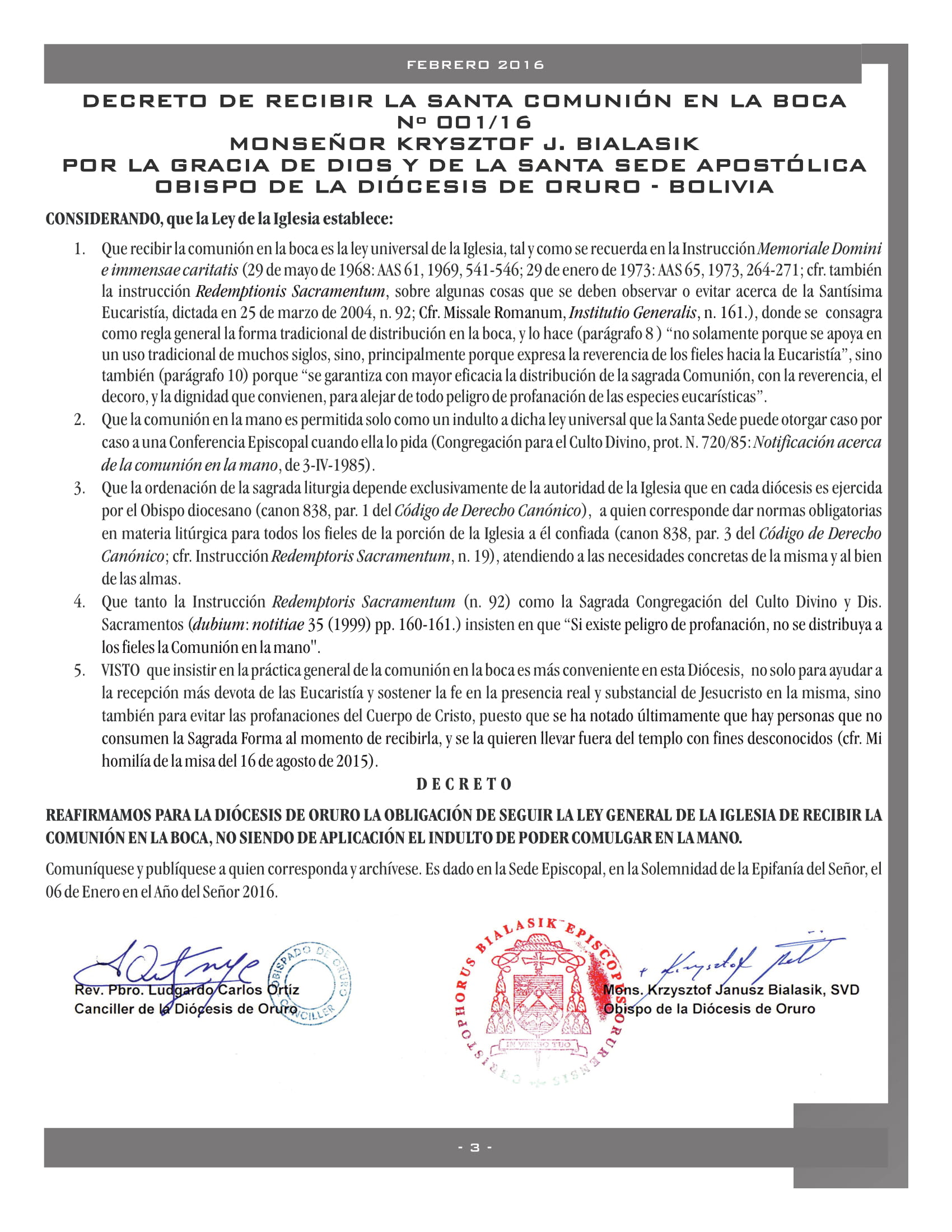
Monseñor Krzysztof Janusz Bialasik, SVD
Obispo de la Diócesis de Oruro – Bolivia

